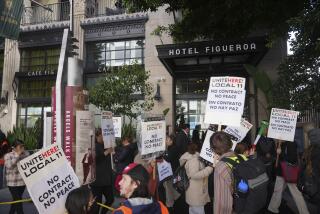Once a ‘Classy’ Place : Old Placentia Hotel May See the Return of Its Days of Glory
PLACENTIA — When the citrus industry thrived, so did the Placentia Hotel.
The two-story brick structure that lines almost half a block of the city’s Santa Fe area was a haven for citrus buyers, who stayed the night there when they surveyed the crops. But by the 1960s, the citrus industry fell victim to development in Orange County, and the hotel went under too.
Anaheim merchant Jose Zepeda wants to bring the hotel back to life. Two months ago, he bought the building and the land, hoping to restore some of its former glory and revive a blighted area.
Plans call for the ground floor to be converted into a 10-shop mercado, with Mexican-theme restaurants and shops, and the second floor to become 21 low-income apartment units. Zepeda hopes that the renovation will be a big step toward making the area resemble Olvera Street in downtown Los Angeles.
When Zepeda, 44, first started negotiating to buy the 20,000-square-foot hotel a year ago, most of the shops on the first level had closed and former hotel rooms were dilapidated and substandard. Although restoring the old building will be a costly venture, Zepeda says that saving an historic structure is well worth it.
“The United States is a rich country, but we have no past,” Zepeda said. “We have to preserve and maintain the (old buildings). We have no old culture.”
Zepeda came to the United States from Mexico in 1966. About eight years later, he opened his first food market and now owns stores in Santa Ana and Maywood. In the 1980s, he began supplementing his food-market businesses by buying old buildings in Orange and Los Angeles counties and renovating them. The Placentia Hotel will be his fifth.
The hotel, also known as the Marjie Building, was called the Hotel Baker when it opened in 1910. Not only was it the first brick building constructed in Placentia, but one of the few at that time to house commercial businesses, including a grocery store and the city’s first telephone exchange. The hotel was renamed the Placentia Hotel in the 1950s.
For a time, when Placentia was rich in citrus and avocado ranches, buyers and guests of ranch owners filled the hotel.
“This was a sought-after place to stay,” said Mike Frazier, the architect on the renovation project who also is researching the building’s history. “It was really classy.”
Zepeda bought the building for $700,000, and renovation is expected to cost another $1 million. So far, he has received no redevelopment funds, although he plans to apply. A large share of the cost will go toward making the structure earthquake-safe and to bring it up to building codes, including installing new heating, air conditioning, electricity and a sprinkler system.
The project will be similar to the Kraemer Building, a structure that Zepeda owns just down the road at the corner of Bradford Avenue and Santa Fe Street. Already, Zepeda has received 47 applications for the low-income apartments there, he said, and a food market opened earlier this month on the street level.
As part of the hotel renovation, the second floor will be extended across the entire span of the building to an old two-story bank building on the corner of Santa Fe and Main streets.
Zepeda hopes that the hotel renovation will be a giant step toward reviving Santa Fe Street, which is part of Placentia’s redevelopment area. For much of the 1980s, Santa Fe business owners had to struggle with crime, including shootings, stabbings and murders.
But in the past two years, the incidence of crime has gone down and rowdy bars in the area have been closed, Placentia Police Lt. Chuck Babcock said. Business owners also are more united and formed the Placita Santa Fe Merchants Assn. two years ago.
“We want to make something to attract families, mom, dad and the kids,” Zepeda said. “We want them to know it’s a safe place.”
More to Read
Sign up for The Wild
We’ll help you find the best places to hike, bike and run, as well as the perfect silent spots for meditation and yoga.
You may occasionally receive promotional content from the Los Angeles Times.





